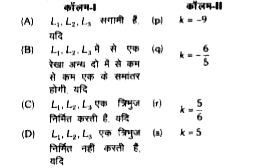यदि z1,z2,z3,z4 समीकरण a0z4+a1z3+a2z2+a3z+a4=0 के मूल हैं
जहाँ a0,a1,a2,a3 और a4 वास्तविक है, तब
¯z1,¯z2,¯z3,¯z4 भी समीकरण के मूल हैं
z1 कम से कम ¯z1,¯z2,¯z3,¯z4 इनमें से एक के बराबर हैं
−¯z1,−¯z2,−¯z3,−¯z4 भी समीकरण के मूल हैं
इनमें से कोई नहीं
The correct Answer is:A, B
Step by step video, text & image solution for यदि z_1,z_2,z_3,z_4 समीकरण a_0z^4+a_1z^3+a_2z^2+a_3z+a_4=0 के मूल हैं जहाँ a_0,a_1,a_2,a_3 और a_4 वास्तविक है, तब by Maths experts to help you in doubts & scoring excellent marks in Class 12 exams.
Topper's Solved these Questions
- BOOK - ERRORLESS HINDICHAPTER - सम्मिश्र संख्यायेंEXERCISE - Jee Advanced (Reasoning)6videos
सम्मिश्र संख्यायें
- BOOK - ERRORLESS HINDICHAPTER - सम्मिश्र संख्यायेंEXERCISE - Jee Advanced (Comprehension)26videos
सम्मिश्र संख्यायें
- BOOK - ERRORLESS HINDICHAPTER - सम्मिश्र संख्यायेंEXERCISE - Exercise117videos
सम्मिश्र संख्यायें
- BOOK - ERRORLESS HINDICHAPTER - समुच्चय सिद्धान्त तथा सम्बन्ध EXERCISE - JEE Advanced (Reasoning type questions)3videos
समुच्चय सिद्धान्त तथा सम्बन्ध
- BOOK - ERRORLESS HINDICHAPTER - सरल रेखा EXERCISE - JEE ADVANCE (Matrix Match type questions)4videos
सरल रेखा
Similar Questions
कथन-1: यदि n एक विषम पूर्णांक 3 से बडा है लेकिन 3 का गुणज नहीं है, तब (x+1)n−xn−1,x3+x2+x से विभाज्य है।
कथन-2: यदि n एक विषम पूर्णांक 3 से बड़ा है लेकिन 3 का गुणज नहीं है हम लेते हैं 1+ωn+ω2n=303:31View Solutionमाना A, B, C तीन सम्मिश्र संख्याओं के समुच्चय निम्न प्रकार से परिभाषित हैं
A={z:Imz≥1}
B={z|z−2−i∣=3}
C={z:Re((1−i)z)=√2} .
तब समुच्चय A∩B∩C में अवयवों की संख्या है04:11View Solutionयदि z≠0 एक सम्मिश्र संख्या हो, तो
03:09View Solutionमाना R वास्तविक संख्याओं का समुच्चय है
कथन-1 : A={(x,y)∈R×R:y−x एक पूर्णांक है} R पर एक तुल्यता संबंध है |
कथन-2 : B={(x,y)∈R×R:x=αy किसी परिमेय संख्या α के लिए} R पर एक तुल्यता संबंध है |07:57View Solution 04:32View Solution
04:32View SolutionFOr an integer nlt2, we have real numbers a_1,a_2,a_3,a_4,..........,a_n such that a_2+a_3+a_4+.......+a_n=a1 and a_1+a_3+a_4+...........+a_n=a_2...............a_1+a_2+a_3+..............+a_(n-1)=a_n what is the value of a_1+a_2+a_3+........+a_n?
03:28View SolutionIf a1,a2,a3,a4 are the coefficients of 2nd, 3rd, 4th and 5th terms of respectively in (1+x)n then a1a1+a2+a3a3+a4=
02:04View SolutionIf a2a3a1a4=a2+a3a1+a4=3(a2−a3a1−a4) then a1,a2,a3,a4 are in :
11:47View SolutionIf a1,a2,a3,a4 are the coefficients of 2nd, 3rd, 4th and 5th terms of (1+x)n respectively then a1a1+a2,a2a2+a3,a3a3+a4 are in
02:20View SolutionIf the equation z4+a1z3+a2z2+a3z+a4=0 where a1,a2,a3,a4 are real coefficients different from zero has a pure imaginary root then the expression a3a1a2+a1a4a2a3 has the value equal to
07:01View Solutionयदि समीकरण z4+a1z3+a2z2+a3z+a4=0 (जहाँ a1,a2,a3,a4 वास्तविक गुणांक है शून्य को छोड़कर) के मूल पूर्णतः काल्पनिक है तब a3a1a2+a1a4a2a3 का मान है -
05:58View SolutionThe average of a1,a2,a3,a4 is 16. Half of the sum of a2,a3,a4 is 23. What is the value of a1
10:40View SolutionIf the coefficient of-four successive termsin the expansion of (1+x)n be a1,a2,a3and a4respectivel. Show thata1a1+a2+a3a3+a4=2a2a2+a3
01:56View SolutionLet A be the set of 4-digit numbers a_1 a_2 a_3 a_4 where a_1 > a_2 > a_3 > a_4 , then n(A) is equal to
03:22View SolutionIf a2a3a1a4=a2+a3a1+a4=3(a2−a3a1−a4) then a1,a2,a3,a4 are in :
03:45View Solution

